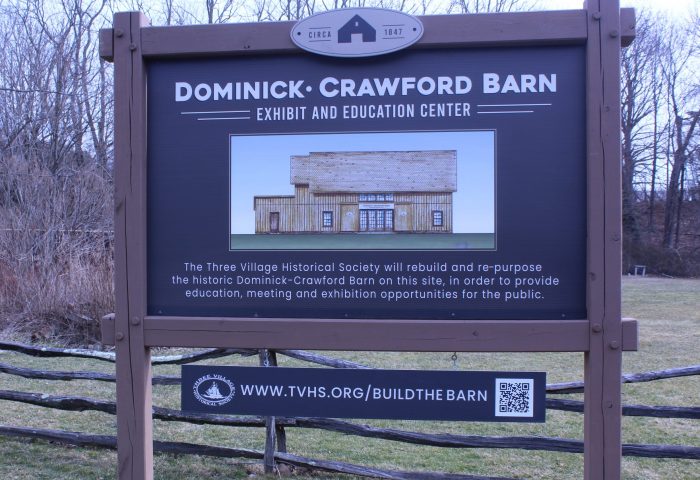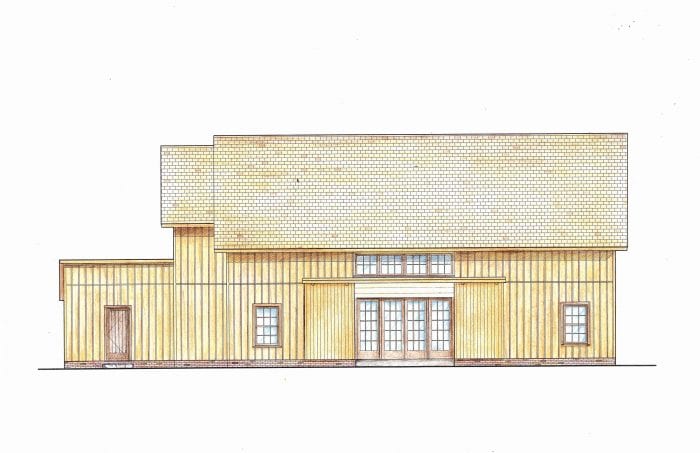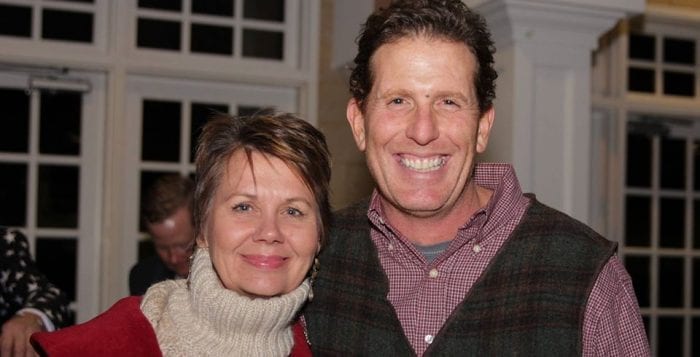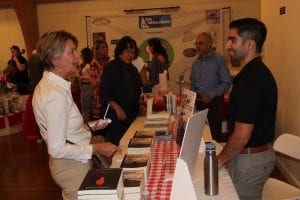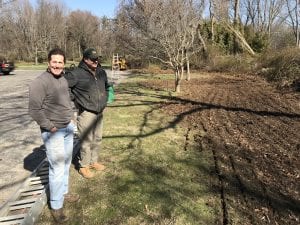By Mallie Jane Kim
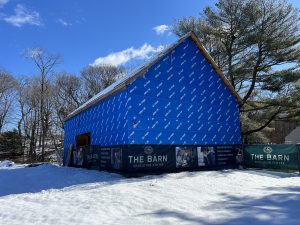 Setauket’s historic district shouldn’t be marked by a bright-blue-wrapped, half-finished barn for much longer, as the Three Village Historical Society plans to start working in earnest on the Dominick-Crawford Barn Education and History Center just as soon as the weather thaws and their supply orders come in.
Setauket’s historic district shouldn’t be marked by a bright-blue-wrapped, half-finished barn for much longer, as the Three Village Historical Society plans to start working in earnest on the Dominick-Crawford Barn Education and History Center just as soon as the weather thaws and their supply orders come in.
“You’re going to see a lot going on in the spring,” said Steve Hintze, who has been on the TVHS barn committee since its inception. “We ran into roadblocks, which seems to be par for the course, but now we’re ready and have everything set to really start moving.”
The society raised the barn exterior quickly last year, only to stall in the fall due to design changes that needed assessment by the Historic District Advisory Committee, a citizen group appointed by Brookhaven Town Board to advise the planning commissioner on changes in historical districts.
The committee recommended adjustments to the society’s altered plans, including to the spacing of seams on the metal roof as well as to the color of the exterior, according to Hintze, who was TVHS president when the society began the barn process in 2014. Hintze added that some of the proposed changes were due to cost increases after the COVID-19 pandemic. The society moved toward less expensive but still historically-accurate materials, and away from a pricey cedar roof and particular windows that had shot up in cost.
“We had enough money to get everything done before the pandemic,” he said. “Due to the pandemic, the cost doubled — flat out doubled.”
This start-and-stop rhythm has been nothing new to the TVHS barn project, which ran into roadblocks from the beginning. The society took down the original 1840s barn from its location in Old Field in 2014, with plans to use the wood to reconstruct a historic barn structure within a commercial shell that could host exhibits and events. According to Hintze, in the process of seeking permits with the Town of Brookhaven, the society learned their building lacked an appropriate Certificate of Occupancy, an issue he said was left over from the previous owner, and there were several past clerical errors that needed ironing out.
“So once we started the project, we immediately started moving forward and then had to slow down,” Hintze said. “Then we move forward and then slow down. So that was the beginning of the barn taking a while to get accomplished.”
Then in 2022, someone cut and stole some key pieces of the original barn wood — including the longest piece. To solve that, the society has additional same-period wood coming from other places locally and from around New York state.
One design sticking point is whether the society can use the high-density engineered wood LP SmartSide siding on the outside structure, which requires less labor and comes with a 50-year guarantee, or whether they need to use historically-accurate siding material like cedar or pine. Hintze said the society would like to consider long-term costs in maintaining the barn, with a material he said is indistinguishable in appearance from classic wood and far more resistant to bad weather, woodpeckers and other wood-destroying creatures.
But some TVHS board members and members of the HDAC have been hesitant, if not against using the material. Town councilmember Jonathan Kornreich (D-Stony Brook), who is familiar with the arguments for and against LP siding on the barn, explained the hesitancy comes from those concerned about historical accuracy — much like a Model T car club using modern materials to restore historic vehicles.
“If you get leaders in who say, ‘Hey, what if we put a Honda engine in the Model T, or fiberglass siding, or maybe air conditioning to be more comfortable,’ at some point, you’re not the Model T car club anymore,” the councilmember said.
Kornreich added that a decision about siding material is a big deal because Setauket’s historic district is one of the strictest in Suffolk County. If LP is allowed there, the door opens for it to be used in other historical applications.
But that reason is one TVHS leaders see as a possible plus, opening the door for forward-looking materials in historical contexts. “There’s something to be said about the historical society being able to set a standard, if we’re using these other materials, let’s use the very best of it,” explained society director Mari Irizarry. “Solar panels weren’t approved in the historic district for years, and now they are.”
Hintze said any debate surrounding LP siding shouldn’t slow down the barn building, and added that they are open to cedar if that will get the barn project finished. “It’s not structural — it’s the last thing that goes up,” Hintze said. “It really is something that can come down to the wire.”
In the meantime, the $300,000 JumpSMART grant the society recently received from Suffolk County will help move construction forward, and TVHS community engagement manager Kimberly Phyfe is planning to ramp up fundraising efforts in coming months. “We still have a little ways to go in terms of fundraising and grant writing,” she said, adding that she is hoping the barn will be ready to host visitors by the society’s annual Candlelight House Tour this December.

